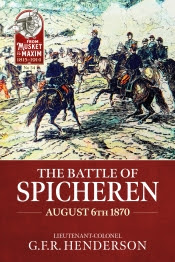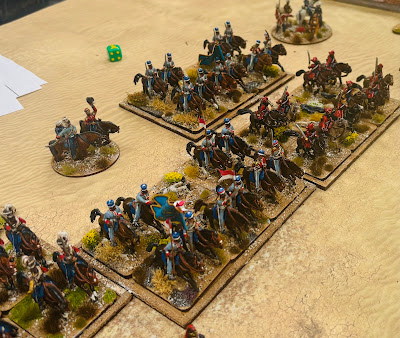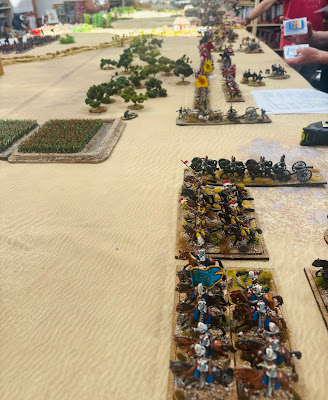I haven’t done any book reviews for a little while so here are three all at once. Each is a new or revised edition of volumes published by Helion a dozen or so years ago focussing on the opening moves of the France-Prussian War. They are of course wonderful.
The Campaign in Alsace August 1870 by Brigadier-General J.P. Du Cane CB is a new edition of the book originally published by Helion in 2010. It is number 56 in their excellent ‘from Musket to Maxim’ series. It provides an account of the early phases of the Franco-Prussian War, specifically examining French and German military actions in the Alsace region and the battles of Weissenburg and Wörth. First published in the late nineteenth century, it combines historical analysis with military commentary and reflects the author's experience as a British officer observing European warfare during this period.
The focus is primarily on high-level operations and command decisions, with less attention paid to the experiences of rank-and-file soldiers or broader socio-political context. Du Cane examines troop movements, command decisions, and battlefield outcomes using a methodical approach. The analysis is presented in a factual, restrained manner without emotional or nationalistic language. This approach provides credibility when comparing French and German military operations. The author reviews the structure of the French command, noting challenges with cohesion and preparedness, and describes the strategic discipline and operational efficiency exhibited by the Prussian forces.
A notable strength of the book is its inclusion of seven clearly drawn maps and tactical sketches, which I found helpful in visualising complex manoeuvres, particularly those related to the battles of Weissenburg and Wörth. These features contributed to my understanding of the ways in which terrain and timing affected the outcomes. There are four appendices which give detailed orders of battle for Weissenburg and Wörth.
Overall, The Campaign in Alsace August 1870 remains a valuable resource for students of military history, especially those like me who are interested in the Franco-German War, nineteenth century warfare, and the evolution of operational doctrines. While not a narrative history in the modern sense, it offers a disciplined, insider’s look at a pivotal campaign through the eyes of a contemporary military observer.
ISBN: 978-1-804518-82-3 101 pages, paperback
The Battle of Spichern is a new edition of the original book Helion published in 2009. It is more than a retelling of a nineteenth century clash but more of a tactical masterclass. Written by G.F.R. Henderson in 1891, who was a British Army officer and respected military thinker, this book breaks down the August 1870 battle between French and Prussian forces with great precision and dramatic clarity.
Through detailed maps, tactical sketches of the battlefields drawn from ground level, eyewitness reports, and detailed analysis of each stage of the battle, Henderson explains how leadership, terrain, weaponry, and sheer human will, contributed towards the ultimate the outcome. What unfolds is a timeless study in battlefield decision making, command under pressure, and the real consequences of tactical error. Despite its age and writing style I found the narrative completely enthralling and despite knowing the ending it was a difficult book to put down.
In addition to aforementioned maps and so forth there are a large number of contemporary black and white illustrations and a complete order of battle for both the French and Prussian armes and a breakdown average strengths and of losses suffered. One fact I found especially interesting was that in terms of number actually engaged, the figures are pretty much even.
Whether you're a military history enthusiast, student of leadership, or just love a gripping true story, The Battle of Spicheren remains essential reading. I found it clear, compelling, and surprisingly relevant more than 130 years after it was written.
ISBN: 978-1-804518-50-2 273 pages, paperback

Originally published in 1891, The Battle of Wörth by George F.R. Henderson represents a significant contribution to classic military history literature. The work provides a concise yet comprehensive analysis of one of the earliest major engagements of the Franco-Prussian War, detailing the conflict between Marshal MacMahon’s French troops and the German forces led by Crown Prince Frederick. This revised edition, first issued by Helion in 2013, incorporates a curated collection of pertinent images and an extensive bibliography related to the Battle of Worth. Additionally, it features a new foreword by Helion owner Duncan Rodgers.
Henderson, a British Army officer and one of the most respected military historians of his day, wrote this primarily for fellow professionals — and it shows. If you enjoy studying how nineteenth century armies were armed, organised, moved, fought, and failed, you’ll find it deeply rewarding. Certainly the depth of research and the detailed analysis of every moment of the battle makes for a gripping read as we get a blow-by-blow account of the battle.
There are 22 contemporary black and white illustrations and photographic portraits of some of the key players on both sides. The images of troops in action are excellent, being full of movement. There are five excellent maps and two detailed panoramic sketches of the battlefield, one each from the French and German perspectives.
The book also boasts seven appendices. As well as the extensive orders of battle, there are others covering the losses incurred by both armies; some French regiments suffered between 77 and 93 percent losses and were effectively annihilated. Indeed a staggering 50 percent of the infantry and 32 percent of the cavalry were casualties on the day, which totalled around 8,000 killed and wounded and 6,000 unwounded prisoners. German losses were numerically slightly higher but as a percentage just 11 percent of those engaged. German artillery expenditure (nearly 10,000) is also included, together with a breakdown by target type of the effective range of German artillery. We then have extracts from regimental histories which give an insight into infantry fighting at regimental and lower levels. Finally, Duncan has compiled a comprehensive guide for further reading which is an extensive, massively diverse, list of reference material. Some of it is general ‘stuff’ (official or general histories of the war) but also included are a significant number of French and German regimental histories, usefully grouped together by corps or division.
There is very little on the politics, civilian experience, or larger context of the war; rather the focus is wholly on what it should be – the battle. This is a soldier writing for soldiers, and the style could be considered dry and dated by today’s standards, it being written in 1899. I cannot say I found this to be the case. Henderson’s clarity of thought and respect for both French and German command make it a most worthwhile read for any serious student of military history. I am fascinated with the Franco-Prussian War and have no problem in recommending this book to like-minded souls. If you missed Helion’s first release then it is well worth buying now.
ISBN: 978-1-804517-90-1 119 pages, paperback


























































